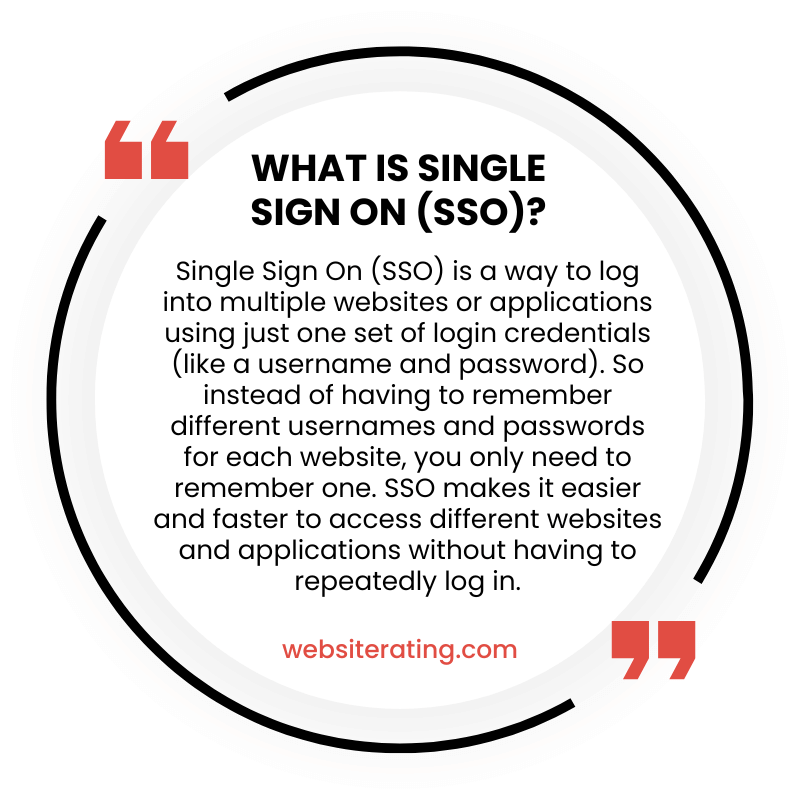Single Sign-On (SSO) is a technology that allows users to access multiple applications with one set of login credentials. It is a type of authentication process which simplifies the login process for users by eliminating the need to remember multiple usernames and passwords. SSO also reduces the risk of unauthorized access, since only one set of logins needs to be secured.

Single Sign-On can be deployed either within an organization or across different organizations, such as those offering cloud services. By centralizing authentication and authorization processes, it provides enhanced security for user accounts while reducing complexity for both IT departments and end-users alike. Furthermore, it ensures that user data is accessible from anywhere at any time with minimal effort on the part of both administrators and users.
This article will explain how SSO works, its benefits and drawbacks, as well as provide practical examples for beginners interested in using this technology. This article will discuss in detail how SSO works, its advantages and disadvantages, plus offer practical examples for novice users wishing to get started with this technology.
What is Single Sign-On?
Authentication with a single set of credentials is used to access multiple applications or services. Single Sign-On (SSO) is an authentication process that enables users to securely authenticate with multiple applications and websites by using just one set of credentials, such as username/password combinations. SSO improves the user experience by eliminating the need for users to remember multiple usernames and passwords. Additionally, it reduces the risk of exposing sensitive information through phishing attacks since users only enter their credentials once.
The SSO process involves two main components: identity provider (IDP) and service provider (SP). The IDP holds the user’s credentials and authenticates them when they attempt to log in; this may be a third-party platform like Facebook or Google, or an on-premise system such as Active Directory or LDAP. The SP is then responsible for providing access to resources based on the authentication result from the IDP.
Practical examples of SSO include corporate networks where employees can access multiple internal applications with one login, or school systems where students can log into different educational platforms using a single set of school-issued credentials.
How Does SSO Work?
Through the use of centralized identity and access management, SSO enables users to authenticate once in order to gain access to multiple applications. This is achieved by the user entering their login credentials into a central authentication system, which then verifies and authenticates the user’s identity. This allows the user to seamlessly move from application to application without having to re-enter their credentials for each one.
The SSO system also stores user profiles centrally, allowing different applications within an organization or network to share information about a single user. The process of SSO can be broken down into four distinct steps: authentication, authorization, session management, and sign out.
Authentication involves verifying a user’s identity by having them enter their username and password or other identifying information into a central authentication server. Authorization ensures that each user has permission to access specific resources within an organization or network based on predetermined criteria such as role-based access control (RBAC).
Session management maintains active sessions between applications throughout a single log-in event while sign out terminates all active sessions associated with that particular account when the user logs out.
Benefits & Drawbacks of Implementing SSO
The implementation of SSO offers organizations an efficient and secure way to authenticate their users, while providing a range of other benefits that can revolutionize the user experience. One such benefit is increased convenience for the user; instead of having to remember multiple passwords for different applications, they only need one username and password combination. This eliminates the risk of users using weak or duplicate passwords – something which can increase security risks across an entire system.
Furthermore, SSO helps to decrease the burden on IT support staff by enabling them to manage authentication centrally through a single administrative interface. This also allows automated processes like login tracking and access control management tasks to be more easily implemented. Another advantage of implementing SSO is improved scalability which enables organizations to quickly add new applications without needing separate authentication protocols.
However, there are some drawbacks associated with SSO implementation that must be considered carefully before making any decision. For example, if an organization suffers from a data breach or their identity provider becomes compromised, then every application connected will be affected simultaneously due to its centralized nature. Additionally, if users forget their credentials then a high level of technical expertise may be needed in order to reset them as all logins are handled in unison through one provider.
Summary
Conclusion:
Single Sign-On (SSO) is a centralized authentication system that allows users to access multiple applications and networks using one set of credentials. This modern security approach eliminates the need for users to remember various passwords, while providing an extra layer of protection.
SSO allows organizations to reduce administrative costs, increase user convenience, and improve data security. While its implementation can be complex and costly, the advantages it provides make it a valuable asset for any organization looking to simplify their authentication processes.
More reading
Single sign-on (SSO) is a user authentication scheme that allows users to access multiple applications and services using just one set of login credentials (source: TechTarget). With SSO, users only have to enter their login credentials once to access all the applications they have been given rights to (source: Wikipedia). SSO eliminates the need for users to remember multiple usernames and passwords, and it also improves security by reducing the risk of password fatigue and phishing attacks.
